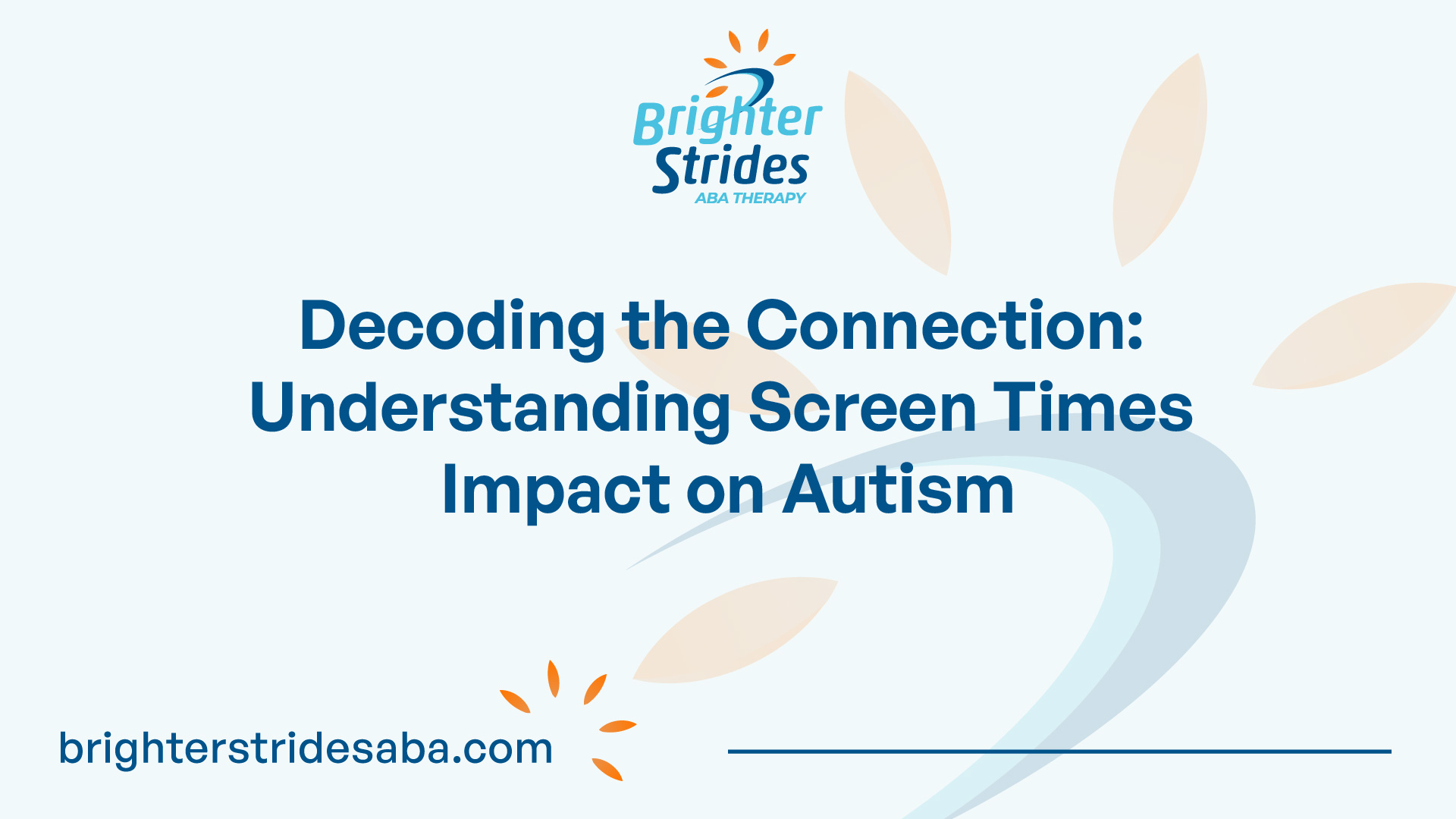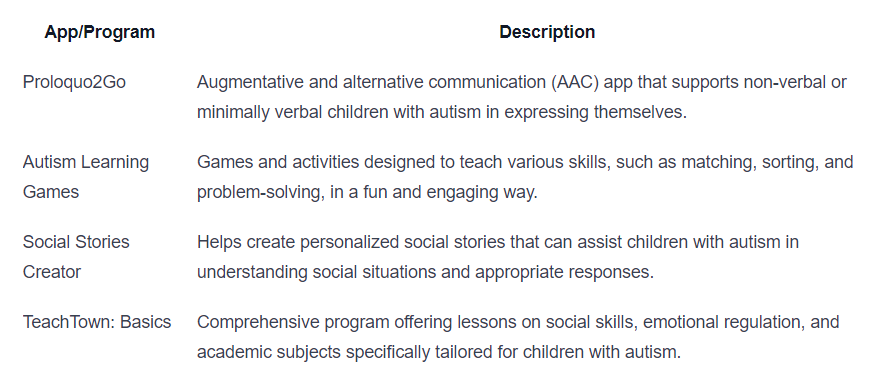The Relationship Between Screen Time and Autism
The impact of screen time on children, particularly in relation to autism, has become a topic of growing interest. Research has explored the potential connection between screen time and autistic symptoms. Understanding this relationship is essential for parents, caregivers, and professionals involved in the care of children with autism.

Screen Time and Autism: A Recent Study
A recent study found a significant association between longer durations of screen time among 1-year-old boys and the subsequent development of autism spectrum disorder (ASD) at 3 years old. Although the study did not specify the exact amount of screen time leading to an autism diagnosis, it highlighted the importance of examining the potential impact of screen time on children’s development.
Correlation between Screen Time and Autistic Symptoms
Researchers have discovered a correlation between screen time and autistic symptoms, as well as developmental quotients in children with ASD. The study indicated that the longer the screen time, the more severe the symptoms of ASD, particularly sensory symptoms, and the more apparent the developmental delay, especially in the language domain for children with ASD who had longer screen time and were younger in age.
According to a study published in PubMed Central, children with ASD have longer screen time compared to typically developing children. On average, children with ASD spend approximately 3.34 hours per day on screens, while typically developing children spend about 0.91 hours per day.
The same study also revealed correlations between screen time and the Childhood Autism Rating Scale (CARS) score, as well as the developmental quotient (DQ) of the Gesell Developmental Schedules (GDS). In the longer screen time subgroup of children with ASD, screen time positively correlated with the CARS score and negatively correlated with the DQs of all domains of the GDS. In the younger age group of children with ASD, screen time positively correlated with the CARS score and negatively correlated with the DQs of all domains of the GDS, except for the personal-social behavior domain.
Understanding the correlation between screen time and autism symptoms is crucial for developing guidelines and strategies to support children with ASD. It is important to strike a balance between screen time and other activities, considering the potential risks associated with excessive screen time, particularly for children with autism.
Effects of Screen Time on Children with Autism
When it comes to children with autism, screen time can have both advantages and negative consequences. It is important to understand the potential effects to make informed decisions regarding screen use for children on the autism spectrum.
Advantages of Screen Time for Children with Autism
Screen time can offer several advantages for children with autism. It can serve as a valuable tool to enhance communication skills, promote engagement, and provide access to educational content and apps specifically designed for their needs.
Many parents report that digital devices help their children with autism communicate, develop social skills, learn, and reduce anxiety.
Through interactive apps and programs, children with autism can practice language and social interaction in a comfortable and controlled environment. The visual and auditory elements of screen-based activities can also support their learning and comprehension. Furthermore, the structured nature of certain apps and programs can help children with autism establish routines and predictability, which can be beneficial for their overall development.
Negative Consequences of Excessive Screen Time
While screen time can have advantages, excessive or unregulated use can lead to negative consequences for children with autism. It is important to strike a balance and monitor their screen usage carefully.
Excessive screen time can potentially worsen social interaction and communication challenges, reinforcing repetitive behaviors commonly observed in children with autism. It may also contribute to social withdrawal, decreased physical activity, and disruptions in sleep patterns. These factors can have a detrimental impact on the overall well-being of a child with autism.
Increased screen exposure has been correlated with more severe autism spectrum disorder (ASD) symptoms, particularly sensory issues. Prolonged screen time may overwhelm the senses and contribute to sensory overload, a common challenge for individuals with autism. This overstimulation can have negative effects on a child’s behavior, attention span, and overall sensory regulation.
Furthermore, there is a concern that excessive screen time and the fast-paced nature of media may impact brain development in children, potentially leading to a condition known as “virtual autism.” This condition refers to the presence of autism-like symptoms in children who have not been diagnosed with autism, but whose behavior is influenced by excessive screen exposure.
To ensure a healthy balance, it is crucial for parents and caregivers to regulate screen time and monitor its impact on children with autism. Implementing screen time limits, providing alternative activities, and promoting physical exercise can help mitigate the negative consequences associated with excessive screen use.
Guidelines for Screen Time for Children with Autism
When it comes to screen time for children with autism, it is important to establish guidelines that consider the individual needs and developmental level of each child. Following recommended screen time limits set by pediatric professionals is generally advised.
Recommended Screen Time Limits
The appropriate amount of screen time for children with autism can vary based on factors such as age and individual needs. Although there is no one-size-fits-all approach, it is recommended to follow guidelines for screen time limits as suggested by experts in the field. For example, the Centers for Disease Control and Prevention (CDC) suggests limiting leisurely screen time to 1-2 hours per day for children while ensuring a minimum of 60 minutes of physical activity daily.
By maintaining a balance between screen time and other activities, children with autism can benefit from the advantages of technology while still engaging in important physical and social interactions.
Using Screens as Communication Tools
For non-verbal or minimally verbal children with autism, screens can serve as valuable tools for communication. Augmentative and alternative communication (AAC) apps and devices can provide these children with access to a means of expression and interaction that may otherwise be challenging.
Using screens as communication tools allows children with autism to bridge the gap between their thoughts and the outside world. It enables them to express their needs, thoughts, and emotions, promoting better communication and social interaction.
When incorporating screens as communication tools, it is essential to select appropriate apps and programs specifically designed for children with autism. These educational apps and programs can target various developmental areas, including communication and social skills. By aligning the content with a child’s developmental needs and interests, screen time can be both educational and beneficial.
By following recommended screen time limits and utilizing screens as communication tools, children with autism can navigate the digital world in a way that supports their development and enhances their overall well-being. However, it is important to remember that screen time should always be balanced with other activities, including physical play and social interactions, to ensure a holistic approach to their growth and development.
Selecting Appropriate Content for Children with Autism
When it comes to screen time for children with autism, selecting the right content is crucial to ensure that screen time is not only engaging but also beneficial for their development. Here are two important considerations when choosing content for children with autism: educational apps and programs and aligning content with developmental needs.
Educational Apps and Programs
There are specific educational apps and programs designed for children with autism that target communication, social skills, and other areas of development. These apps and programs provide interactive and engaging activities that can help enhance learning and promote skill development. Examples of educational apps and programs for children with autism include:

By incorporating these educational apps and programs into screen time, children with autism can benefit from targeted interventions and a more personalized learning experience.
Aligning Content with Developmental Needs
It is important to align the content with the developmental needs of children with autism. Different children may have varying abilities and interests, so tailoring the content to their specific needs can enhance engagement and maximize learning opportunities. Consider the following factors when selecting content:
- Age-appropriate material: Choose content that is suitable for the child’s age to ensure that it is both engaging and relevant to their developmental stage.
- Visual cues and supports: Children with autism often respond well to visual supports. Look for content that incorporates visual cues, such as pictures, symbols, or videos, to aid comprehension and understanding.
- Individual interests: Take into account the child’s personal interests and preferences. Content that aligns with their interests can help maintain their attention and motivation during screen time.
By selecting content that is educational, personalized, and developmentally appropriate, screen time can be a valuable tool for children with autism, supporting their learning, communication, and social skills development.
Remember, however, that while screen time can offer advantages, excessive or unregulated screen time can have negative consequences, such as social withdrawal, decreased physical activity, and potential disruptions to sleep patterns. It is important to strike a balance and follow recommended screen time limits set by pediatric professionals to ensure a well-rounded approach to a child’s development.
Balancing Screen Time and Other Activities
When it comes to screen time for children, especially those with autism, finding a balance between digital engagement and other activities is crucial. It’s important to consider two key aspects: the impact on sleep patterns and the importance of physical activity.
Impact on Sleep Patterns
Excessive screen time, particularly before bed, can have a negative impact on sleep patterns in children with autism. Research suggests that media use before bedtime is associated with impairments in sleep in children with Autism Spectrum Disorder (ASD). Sleep disturbances are already more pronounced in this population, and poor sleep patterns have been linked to challenging daytime behaviors in children and young adults with ASD. Therefore, it becomes essential to minimize or eliminate screen time close to bedtime, allowing for a better quality of sleep.
Importance of Physical Activity
While screen time can provide certain benefits for children with autism, it’s equally important to encourage physical activity as part of a balanced routine. Engaging in physical activities has numerous advantages, including promoting overall health, improving motor skills, and providing sensory input that can benefit children with autism.
Regular physical activity helps children with autism to release excess energy, reduce stress, and enhance mood. It also contributes to the development of gross motor skills and coordination. Encouraging outdoor play, participating in sports, or engaging in activities such as swimming, biking, or dancing are excellent ways to incorporate physical activity into a child’s routine.
By striking a balance between screen time and physical activity, children with autism can enjoy the benefits of both. It’s important to set clear boundaries and establish a structured schedule that includes dedicated time for physical activities. This helps to ensure that children with autism have a well-rounded routine that addresses their developmental needs.
Remember, every child is unique, and it may be necessary to tailor the balance between screen time and physical activity based on individual preferences and abilities. Regular monitoring and open communication with caregivers, educators, and healthcare professionals can help determine the optimal balance for each child.
Understanding the impact of excessive screen time on sleep patterns and the significance of physical activity allows parents and caregivers to make informed decisions about creating a balanced routine for children with autism. By promoting healthy habits and providing a variety of engaging activities, we can support their overall well-being and development.
Risks and Precautions of Excessive Screen Time
When it comes to screen time and its impact on children with autism, there are important risks and precautions to consider. Excessive screen time can have detrimental effects on various aspects of a child’s well-being, including brain development and social interaction. It’s crucial for parents and caregivers to be aware of these risks and take necessary precautions to ensure a healthy balance.
Potential Impacts on Brain Development
Excessive screen time has been linked to potential impacts on brain development in children. Research suggests that prolonged exposure to screens may lead to white matter changes and neurochemical disruption. These changes can interfere with the normal development of neural connections and may have long-term consequences.
For children with autism, extended screen time can exacerbate their challenges in social interaction and communication. It’s important to remember that children with autism may already have unique sensory and processing differences, and excessive screen time can potentially worsen these symptoms.
Risks of Social Withdrawal and Inappropriate Content
Excessive screen time for children with autism can also contribute to social withdrawal and reinforce repetitive behaviors commonly seen in children with Autism Spectrum Disorder (ASD). Excessive reliance on screens may hinder opportunities for face-to-face social interaction and limit the development of critical social skills.
Additionally, unrestricted access to screens can expose children to inappropriate content, privacy risks, cyberbullying, and emotional harm. It’s crucial for parents and caregivers to monitor and control the content their children are exposed to, ensuring a safe and appropriate digital environment.
To mitigate these risks, it’s important for parents and caregivers to establish guidelines and set limits on screen time for children with autism. This includes finding a balance between screen time and other activities that promote social interactions, physical exercise, and skill development.
By understanding the potential risks associated with excessive screen time and implementing appropriate precautions, parents and caregivers can help ensure that children with autism have a healthy and well-rounded lifestyle. Monitoring screen time, providing alternative activities, and promoting social engagement are essential steps in fostering the overall well-being of children with autism.
Screen Time and Autism: Research Findings
Understanding the relationship between screen time and autism is crucial in order to make informed decisions regarding technology use for individuals on the autism spectrum. Various research studies have shed light on the correlation between screen time and autism spectrum disorder (ASD) symptoms, as well as the effects of early and prolonged screen exposure.
Correlation between Screen Time and ASD Symptoms
Research has shown a correlation between screen time and autistic symptoms, as well as developmental quotients in children with autism spectrum disorder. A study conducted found that the longer the screen time, the more severe the symptoms of ASD, especially sensory symptoms, and the more obvious the developmental delay, particularly in the language domain for ASD children with longer screen time and younger age. This correlation suggests that excessive screen time may contribute to the manifestation and severity of ASD symptoms in children.
Additionally, autistic children tend to spend more time on screens compared to children without autism. According to Autism Parenting Magazine, about 64.2% of young adults with ASD spend their free time on TV and video games. Increased screen exposure has been associated with more severe ASD symptoms, particularly sensory issues.
Effects of Early and Prolonged Screen Exposure
The duration and timing of screen exposure can also have significant implications for the development of autism spectrum disorder. According to a study published in the National Center for Biotechnology Information, the longer the period of screen exposure, the higher the risk that a child may develop ASD. Furthermore, the earlier the child is exposed to screens, the higher the risk of developing ASD compared to children exposed later.
Prolonged screen exposure at an early age may pose risks to brain development and potentially contribute to a condition known as “virtual autism,” which presents with autism-like symptoms in children. Therefore, it is crucial to exercise caution and regulate screen time, particularly in the early stages of a child’s development.
Understanding the correlation between screen time and autism, as well as the effects of early and prolonged screen exposure, can guide parents, caregivers, and professionals in making informed decisions about technology use for individuals with autism spectrum disorder. It is important to strike a balance between screen time and other activities, ensuring that individuals with autism have a well-rounded and developmentally appropriate environment.
Regulating Screen Time for Children with Autism
When it comes to children with autism, regulating screen time is crucial to ensure a healthy balance between technology use and other activities. Here, we will explore the recommended screen time limits and the importance of balancing screen time with physical activity.
Recommended Screen Time Limits
Experts suggest limiting children, including those with autism, to 1-2 hours of leisurely screen time per day, depending on parental preferences. This recommendation comes from the CDC and aims to strike a balance between screen time and physical activity.
It is important to note that excessive screen time can worsen the social interaction and communication challenges often seen in children with autism. Additionally, it may reinforce repetitive behaviors commonly observed in children with autism spectrum disorder (ASD).
Balancing Screen Time with Physical Activity
To ensure a well-rounded routine, it is essential to balance screen time with physical activity. The CDC recommends that children, including those with autism, engage in a minimum of 60 minutes of physical activity daily. This can include activities such as playing outside, participating in sports, or engaging in other forms of exercise.
Physical activity is not only important for maintaining overall health and well-being, but it also helps children with autism develop gross motor skills, socialize with peers, and regulate their sensory experiences. By incorporating physical activity into the daily routine, it can help counteract the potential negative effects of excessive screen time.
By adhering to recommended screen time limits and prioritizing physical activity, parents and caregivers can create a healthy balance for children with autism. This balance promotes the development of important skills and ensures that screen time does not impede proper brain development or exacerbate the challenges associated with autism spectrum disorder.
References
- https://nortonchildrens.com/news/autism-and-screen-time/
- https://www.ncbi.nlm.nih.gov/pmc/articles/PMC7920949/
- https://www.autismparentingmagazine.com/screen-time-kids-with-asd/
- https://doublecareaba.com/how-to-balance-screen-time-for-children-with-autism/
- https://behavioral-innovations.com/blog/regulating-screen-time/
- https://www.ncbi.nlm.nih.gov/pmc/articles/PMC6579611/
- https://www.ncbi.nlm.nih.gov/pmc/articles/PMC10442849/

 We've just released an article!
Check out our blog!
We've just released an article!
Check out our blog!



